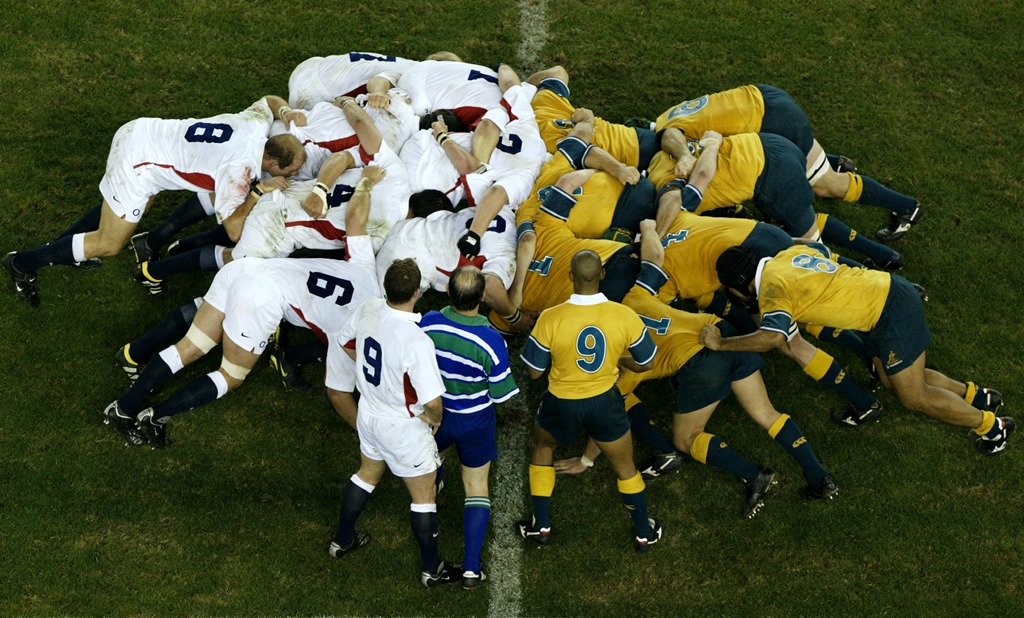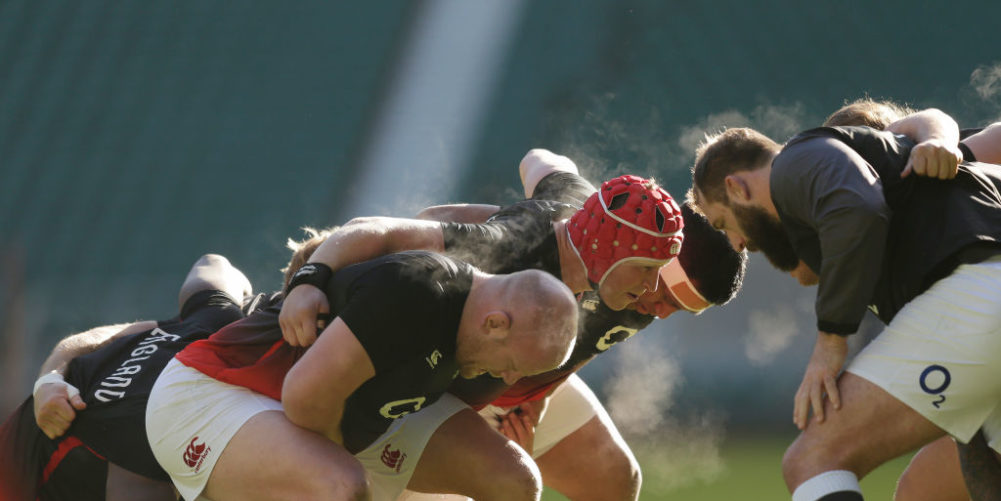IT takes a side with a consistently powerful, cohesive set-piece game to win a World Cup – and currently England do not have what it takes. What is also certain is that unless they develop a world class scrum before the 2019 tournament kicks off in Japan a year from now they cannot be considered true contenders.
The autumn series will provide the litmus test of whether England can make the necessary gains, but Phil Keith-Roach, the peerless 2003 England world champion scrum coach, says that it will take hours of blood, sweat and tears, and attention to detail, to get there.
“One of the saddest things to me is that as soon as you build a decent set piece it gets taken for granted. It is all about consistency at the scrum, where the ball pops out regularly with such efficiency and accuracy that supporters never doubt that it will.”
Keith Roach adds: “England do not have that at the moment. The team whose scrum always delivers is New Zealand, and the speed with which the ball comes back is a joy to see. That’s because with Mike Cron in charge of their scrum the All Black scrum-halves, Aaron Smith and TJ Perenara, spend hours practising with their hookers, putting the ball in to co-ordinate it with the strike. By comparison the striking by England’s hookers is agricultural.”
There was substantial evidence over the course of last season of how far the England scrum has slipped, but if you are looking for one moment that highlighted how much work Eddie Jones, and his scrum coach Neal Hatley, have to do before the World Cup it came in South Africa this summer.
The moment that encapsulated England’s decline as a scrummaging power came in the 48th minute of the second Test in Bloemfontein when they were blasted backwards by an inexperienced Springbok pack. It allowed the hosts to secure a match-clinching penalty try, and with it the series.
This was a shocking register of the decline that has set in since England became world champions in 2003 with a scrum, spearheaded by front row forwards of the calibre of Phil Vickery, Julian White, Steve Thompson, Trevor Woodman and Jason Leonard, that was the most feared on the planet.

Under the tutelage of Keith-Roach the world champion pack was so superior that they had to throttle back in the 2003 final against Australia due to the South African referee, Andre Watson, and his incomprehensible policy of rewarding the vastly inferior Wallaby scrum with get-out-of-jail penalties.
A few months earlier the England side had posted notice of their scrum prowess in the victory over New Zealand in Wellington with an epic goal-line stand in which – with two forwards in the sin-bin – they staved off the full strength All Black pack in a series of six-man scrums.
Those scrum heroics were matched during England’s extraordinary late run to defend their world title in 2007. The pivotal moment came in the quarter-final in Marseille when a hitherto lacklustre England outfit faced an overconfident Australian side which sailed through the pool stage. England’s triumph was based squarely on the massive shoulders of loose-head Andrew Sheridan and his tight-head accomplice Vickery as they did a demolition job on the Wallaby scrum.
Even when England were in the doldrums for long periods in the amateur era their scrum had a hard-earned reputation for toughness, tenacity and technique. It is a legacy that has been guarded zealously by generations of Red Rose forwards – to the extent that even when England have been outplayed in every department, the pack has prided itself on always winning its own ball and putting genuine pressure on the oppositions’.
That bloody-minded attitude was absent in Bloemfontein as England’s scrum was out-thought, out-gunned and out-passioned by a South African outfit, which, to add insult to injury, had hardly played together.
It began with South Africa forcing an attacking 5m scrum immediately after bringing on two fresh props, with tight-head Thomas du Toit replacing Frans Malherbe, and loose-head Steven Kitshoff stepping in for the veteran Tendai Mtawarira.
When the first scrum went down French referee Romain Poite blew for a reset, and the Springboks flexed their muscles for a big push. As the ball was put-in Kitshoff started the assault by getting under Kyle Sinckler and forcing the England tight-head to concede ground before standing up.
In an upright position Sinkler was helpless to disrupt the Springbok drive, and simultaneously it sent the signal to Poite that England were unable to match South Africa’s power. The rot set in because, with his tight-head out of commission, hooker Jamie George then popped up.
On the other side of the scrum Mako Vunipola had also been knocked backwards by Du Toit’s shunt. However, when Vunipola saw the England try line under his feet he remained engaged, and then tried to stem the tide by shifting angle to pack inwards.
This forced the scrum to wheel, and it stopped the Springbok forward momentum, but it was too little too late. Given that South Africa were about to drive over the line with the England scrum platform having disintegrated, the decision to award a penalty try was inevitable and justified.
As the referee went under the crossbar any sense of England coach Jones making good on his promise to restore his side’s traditional set piece might had been blown to smithereens.
South Africa’s scrum dominance was not given much weight outside The Rugby Paper, but there is no doubt that when it comes to striking devastating psychological blows the scrum is still king.

There may not be as many scrums as there used to be, but if you can force errors close to the opposition line and lock their forwards into an eight-on-eight scrum battle there is still nothing more demoralising in Rugby Union than your pack being smashed.
Keith-Roach sums up the psychological swing perfectly. “One-side become giants, and the other become pygmies.”
He says he found the lack of attention paid to England scrum shortcomings against the Springboks alarming. “It has a huge physical and mental effect on the game whether it’s now or at the World Cup, and it’s frequently the difference between winning and losing. That is why the scrum is not a minor issue.”
It is also why England’s penalty try flaws against the Springboks will result in them being targeted in the autumn series, with the Southern Hemisphere big three focused on causing scrum mayhem at Twickenham.
Keith-Roach is an ardent believer that skills and selection are factors that underpin a great scrum, and that England still have time to make the necessary headway. He says that Jones and Hatley are still searching for the right combinations, but that they could start by giving the Worcester tight-head Nick Schonert a chance to prove his credentials this autumn, and developing fierce competition for places with Exeter’s Harry Williams, Leicester veteran Dan Cole and Sinckler also in contention.
“You have to go out and find front row forwards who are rough gems that you need to polish. That’s what I did with players like Vickery, White, Thompson, Woodman and David Flatman. They were unknown when Clive Woodward first became England coach, but they were willing to learn, and were truly tough men who became world-class. You have to be three deep in the front row so you do not suffer when you get injuries, and with established props like Leonard and Graham Rowntree also available we had that depth.”
However, it was the depth of their competitiveness – and their refusal to take second – that turned the likes of Vickery into world beaters. When players in the current England front five are happy to talk blandly about how much they learned in defeat in South Africa, and how well they did in Cape Town to win the third Test of a dead rubber, you fear that they have lost the burning desire to be the best.
That desire is summed up in a couple of recollections from Vickery in Behind The Rose. The first describes his state of mind before the win over New Zealand in Wellington mentioned earlier. “I need emotion when I play rugby. I used to have running arguments with sports psychologists who talked about judgement and calm, and all that. Ice in the head and fire in the belly, and all that rubbish. But I needed fire in the head, legs, feet, toes and ears – that is when I played best.
“When I was in those six-man scrums I was playing for everyone who ever helped me, everything I’d ever worked for. I’m thinking about my mum who drove me thousands of miles in an old Fiesta to every trial and session and match. All the good people at school, and Bude, and Gloucester and Wasps. All the fans and all the physios. We held up in those scrums…it should never have happened, but it did.”
The second anecdote tells of his attempts as England captain to fire up his prop partner Sheridan before the 2007 World Cup semi-final victory over France in Paris.
“Andrew Sheridan was everything I wanted him to be – big, strong, powerful. But if you don’t get him fired up, then he’s not nearly as good.
“I said some things to ‘Shez’ in that changing room before the French game that I wouldn’t ever say to anybody again. So he head-butted me, actually split my head open.
“I can remember the atmosphere even before that, the boys were fired up, some were crying, I tried to cover over the cut, the blood was running down my shirt. Then there was a knock on the door, the official calling us out for the match…”
From what we saw in Bloemfontein that same passion for the battle appears to have bypassed Vickery’s successors in the Red Rose front row. Their challenge is to rediscover it and, combined with the skills and attention to detail that Keith-Roach highlights, there may still be time to construct an England scrum which can go from pushovers to world beaters in Japan next year.























